Production Plant Data Analysis: LDH-5:LDH-1 Ratio and Worker Health
VerifiedAdded on 2023/01/13
|25
|3407
|37
Report
AI Summary
This data analysis report investigates potential health hazards among 127 workers in different production plants, focusing on the LDH-5:LDH-1 ratio as an indicator of liver damage. The analysis uses descriptive statistics, correlation tests (Pearson and Spearman), ANOVA, and Chi-square tests to explore relationships between variables such as sector, length of service, age, gender, and LDH-5:LDH-1 ratio. The report examines hypotheses related to the impact of longer service, age, and gender on worker health, providing statistical evidence to either accept or reject these hypotheses. Findings suggest that longer service and age may correlate with increased health risks, while gender's impact is less clear. The report concludes by summarizing the key statistical findings and their implications for understanding worker health in different industries.
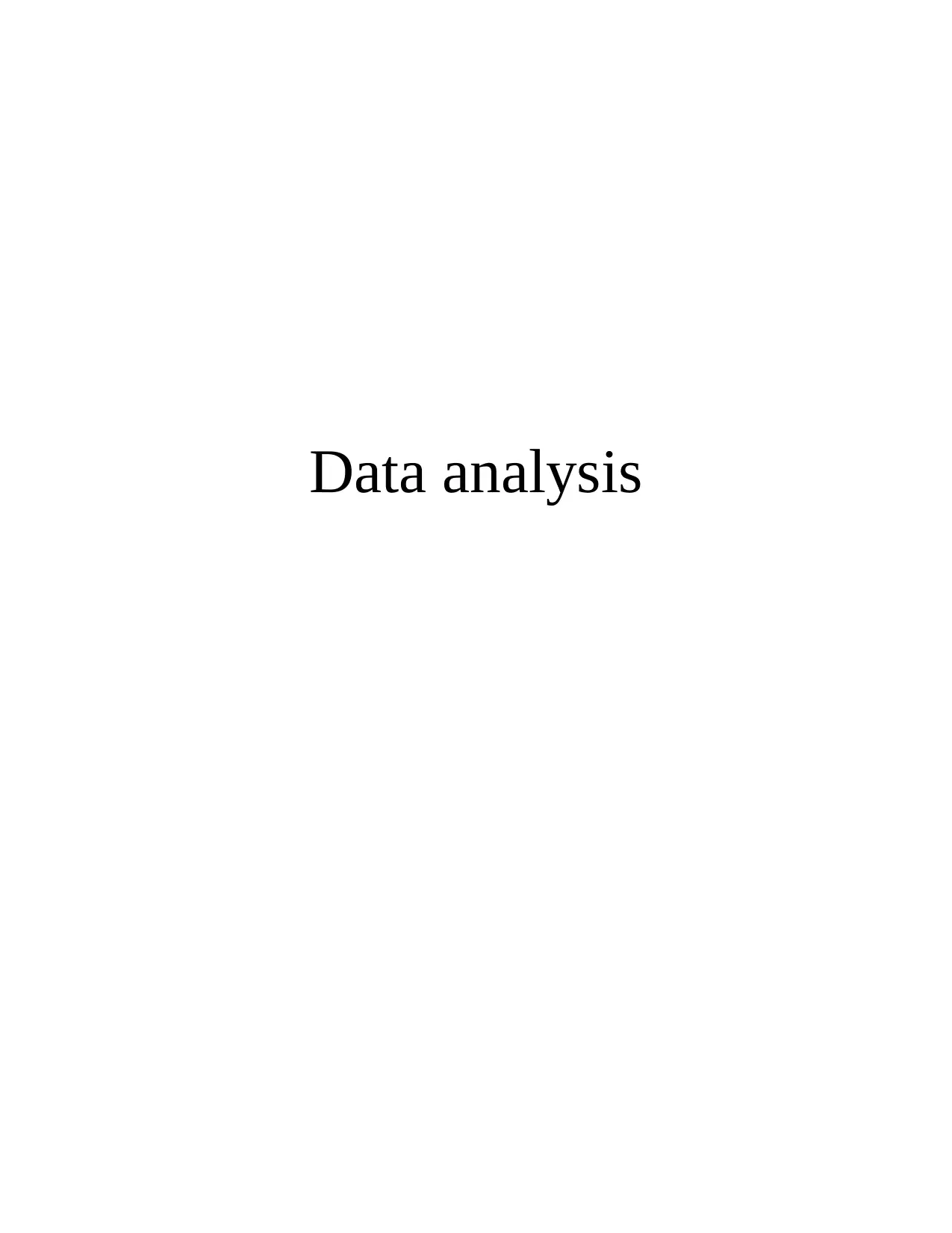
Data analysis
Paraphrase This Document
Need a fresh take? Get an instant paraphrase of this document with our AI Paraphraser
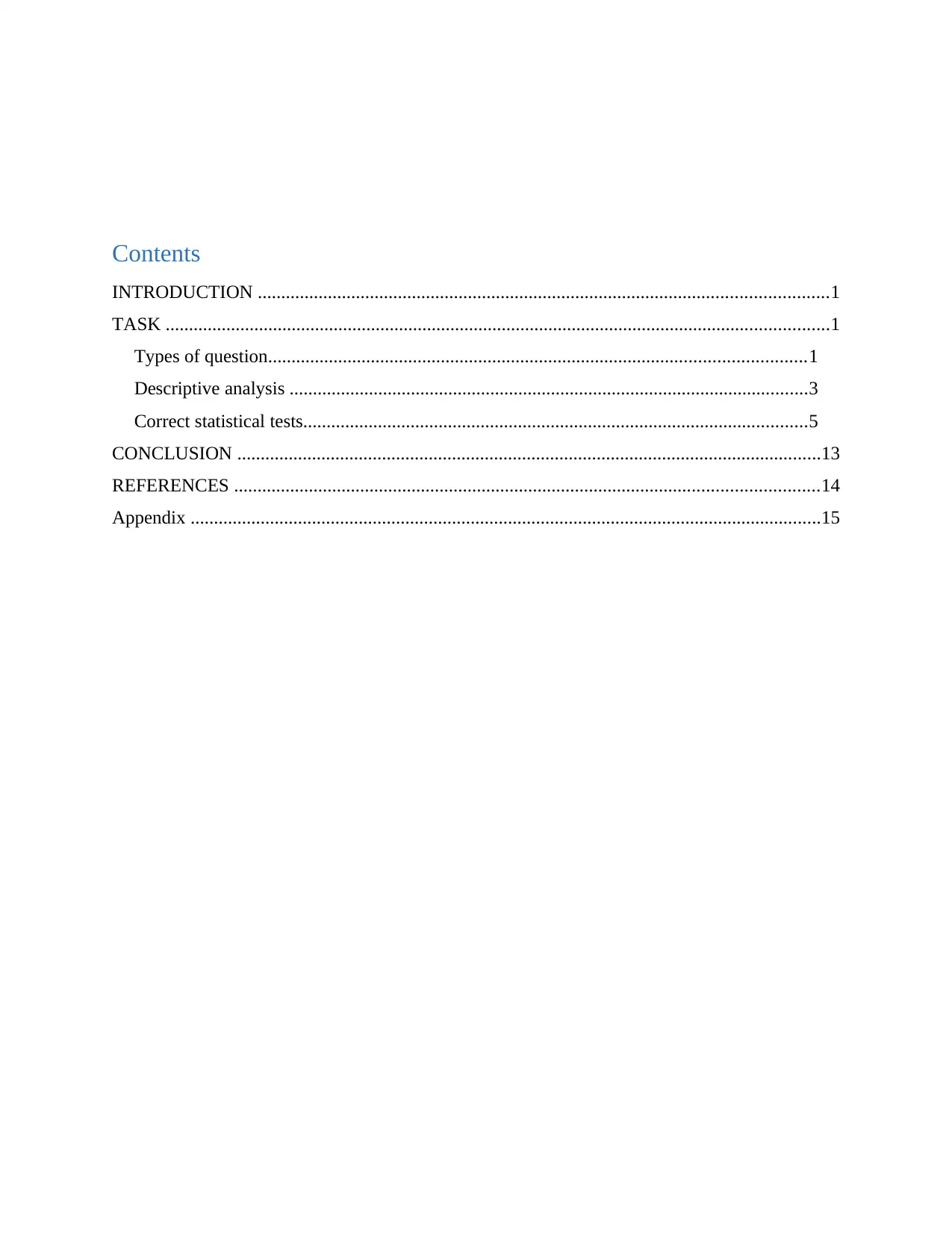
Contents
INTRODUCTION ..........................................................................................................................1
TASK ..............................................................................................................................................1
Types of question...................................................................................................................1
Descriptive analysis ...............................................................................................................3
Correct statistical tests............................................................................................................5
CONCLUSION .............................................................................................................................13
REFERENCES .............................................................................................................................14
Appendix .......................................................................................................................................15
INTRODUCTION ..........................................................................................................................1
TASK ..............................................................................................................................................1
Types of question...................................................................................................................1
Descriptive analysis ...............................................................................................................3
Correct statistical tests............................................................................................................5
CONCLUSION .............................................................................................................................13
REFERENCES .............................................................................................................................14
Appendix .......................................................................................................................................15

INTRODUCTION
The process of recording, evaluating, dissecting information related to a specific topic and them
presenting the main finding into acceptable format which ease the system of decision making is
known as data analysis (Ho, 2013). In order to understand the importance of data analysis sample
of 127 worker working in different production plant are selected that help in extracting valuable
results.
In this report, meaningful evidence of potential health hazard between workers at the
different industries as indicated by the LDH-5: LDH-1 ratio is discussed by using various useful
statistical and descriptive test.
TASK
Types of question
There has been some important question which are formulated to determine the accurate
relationship between the different variable. Such as:
1: The relationship between sector and length of service
Hypothesis: Whether the longer period of service in a specific sector have adverse impact on
health.
Descriptive Statistics
Mean Std.
Deviation
N
sector 2.58 1.087 127
length of service
(years) 8.93 6.452 127
Correlations
1
The process of recording, evaluating, dissecting information related to a specific topic and them
presenting the main finding into acceptable format which ease the system of decision making is
known as data analysis (Ho, 2013). In order to understand the importance of data analysis sample
of 127 worker working in different production plant are selected that help in extracting valuable
results.
In this report, meaningful evidence of potential health hazard between workers at the
different industries as indicated by the LDH-5: LDH-1 ratio is discussed by using various useful
statistical and descriptive test.
TASK
Types of question
There has been some important question which are formulated to determine the accurate
relationship between the different variable. Such as:
1: The relationship between sector and length of service
Hypothesis: Whether the longer period of service in a specific sector have adverse impact on
health.
Descriptive Statistics
Mean Std.
Deviation
N
sector 2.58 1.087 127
length of service
(years) 8.93 6.452 127
Correlations
1
⊘ This is a preview!⊘
Do you want full access?
Subscribe today to unlock all pages.

Trusted by 1+ million students worldwide
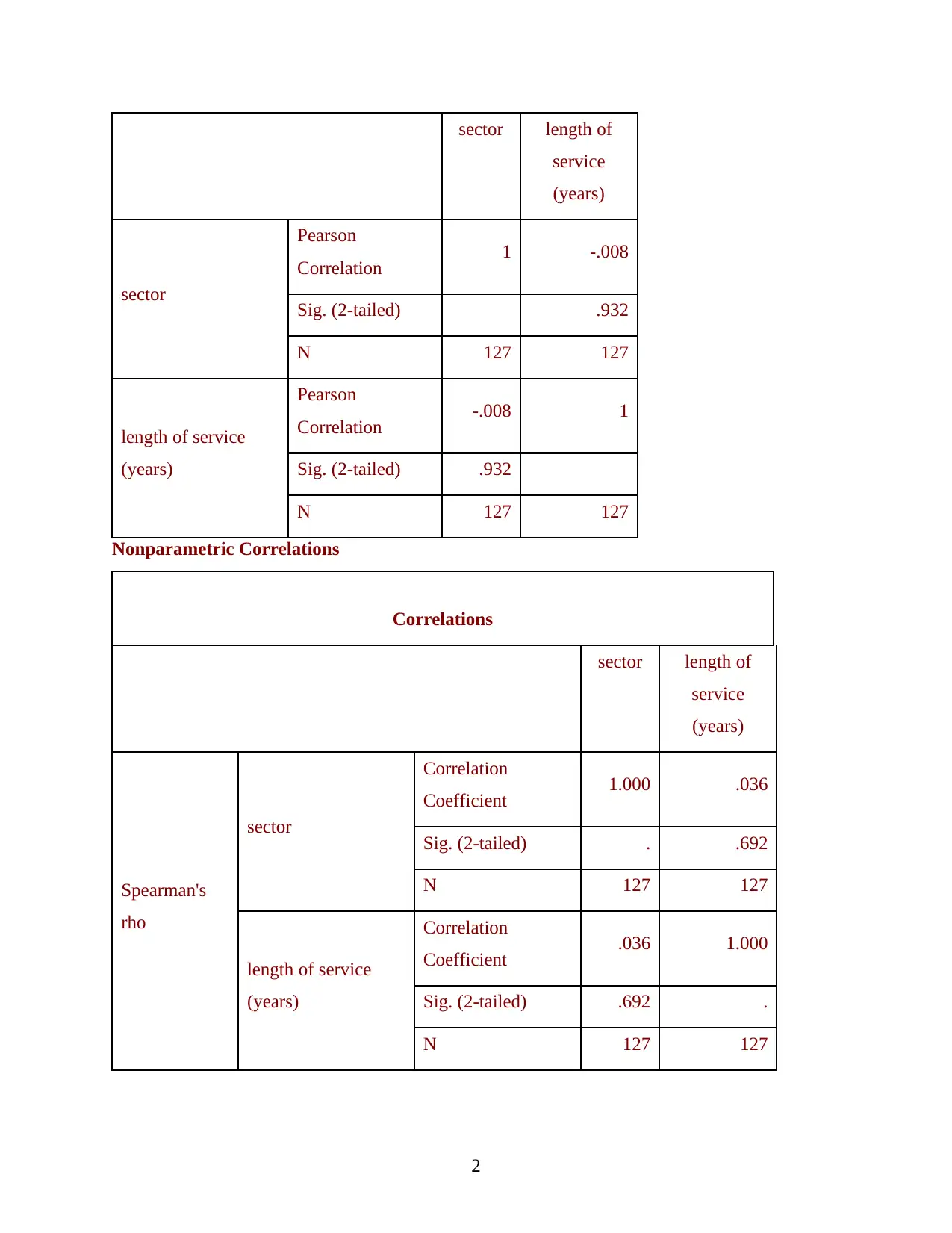
sector length of
service
(years)
sector
Pearson
Correlation 1 -.008
Sig. (2-tailed) .932
N 127 127
length of service
(years)
Pearson
Correlation -.008 1
Sig. (2-tailed) .932
N 127 127
Nonparametric Correlations
Correlations
sector length of
service
(years)
Spearman's
rho
sector
Correlation
Coefficient 1.000 .036
Sig. (2-tailed) . .692
N 127 127
length of service
(years)
Correlation
Coefficient .036 1.000
Sig. (2-tailed) .692 .
N 127 127
2
service
(years)
sector
Pearson
Correlation 1 -.008
Sig. (2-tailed) .932
N 127 127
length of service
(years)
Pearson
Correlation -.008 1
Sig. (2-tailed) .932
N 127 127
Nonparametric Correlations
Correlations
sector length of
service
(years)
Spearman's
rho
sector
Correlation
Coefficient 1.000 .036
Sig. (2-tailed) . .692
N 127 127
length of service
(years)
Correlation
Coefficient .036 1.000
Sig. (2-tailed) .692 .
N 127 127
2
Paraphrase This Document
Need a fresh take? Get an instant paraphrase of this document with our AI Paraphraser
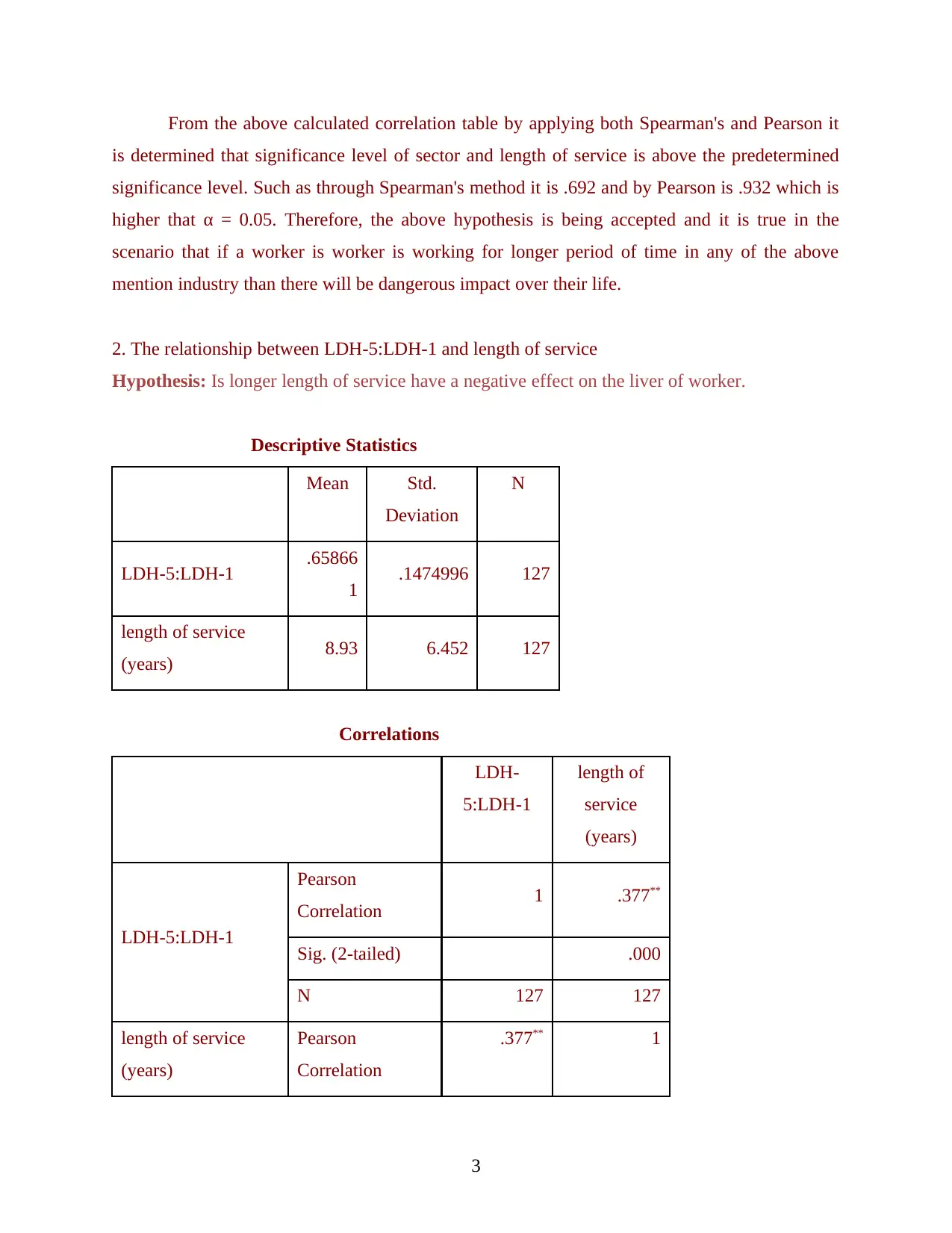
From the above calculated correlation table by applying both Spearman's and Pearson it
is determined that significance level of sector and length of service is above the predetermined
significance level. Such as through Spearman's method it is .692 and by Pearson is .932 which is
higher that α = 0.05. Therefore, the above hypothesis is being accepted and it is true in the
scenario that if a worker is worker is working for longer period of time in any of the above
mention industry than there will be dangerous impact over their life.
2. The relationship between LDH-5:LDH-1 and length of service
Hypothesis: Is longer length of service have a negative effect on the liver of worker.
Descriptive Statistics
Mean Std.
Deviation
N
LDH-5:LDH-1 .65866
1 .1474996 127
length of service
(years) 8.93 6.452 127
Correlations
LDH-
5:LDH-1
length of
service
(years)
LDH-5:LDH-1
Pearson
Correlation 1 .377**
Sig. (2-tailed) .000
N 127 127
length of service
(years)
Pearson
Correlation
.377** 1
3
is determined that significance level of sector and length of service is above the predetermined
significance level. Such as through Spearman's method it is .692 and by Pearson is .932 which is
higher that α = 0.05. Therefore, the above hypothesis is being accepted and it is true in the
scenario that if a worker is worker is working for longer period of time in any of the above
mention industry than there will be dangerous impact over their life.
2. The relationship between LDH-5:LDH-1 and length of service
Hypothesis: Is longer length of service have a negative effect on the liver of worker.
Descriptive Statistics
Mean Std.
Deviation
N
LDH-5:LDH-1 .65866
1 .1474996 127
length of service
(years) 8.93 6.452 127
Correlations
LDH-
5:LDH-1
length of
service
(years)
LDH-5:LDH-1
Pearson
Correlation 1 .377**
Sig. (2-tailed) .000
N 127 127
length of service
(years)
Pearson
Correlation
.377** 1
3
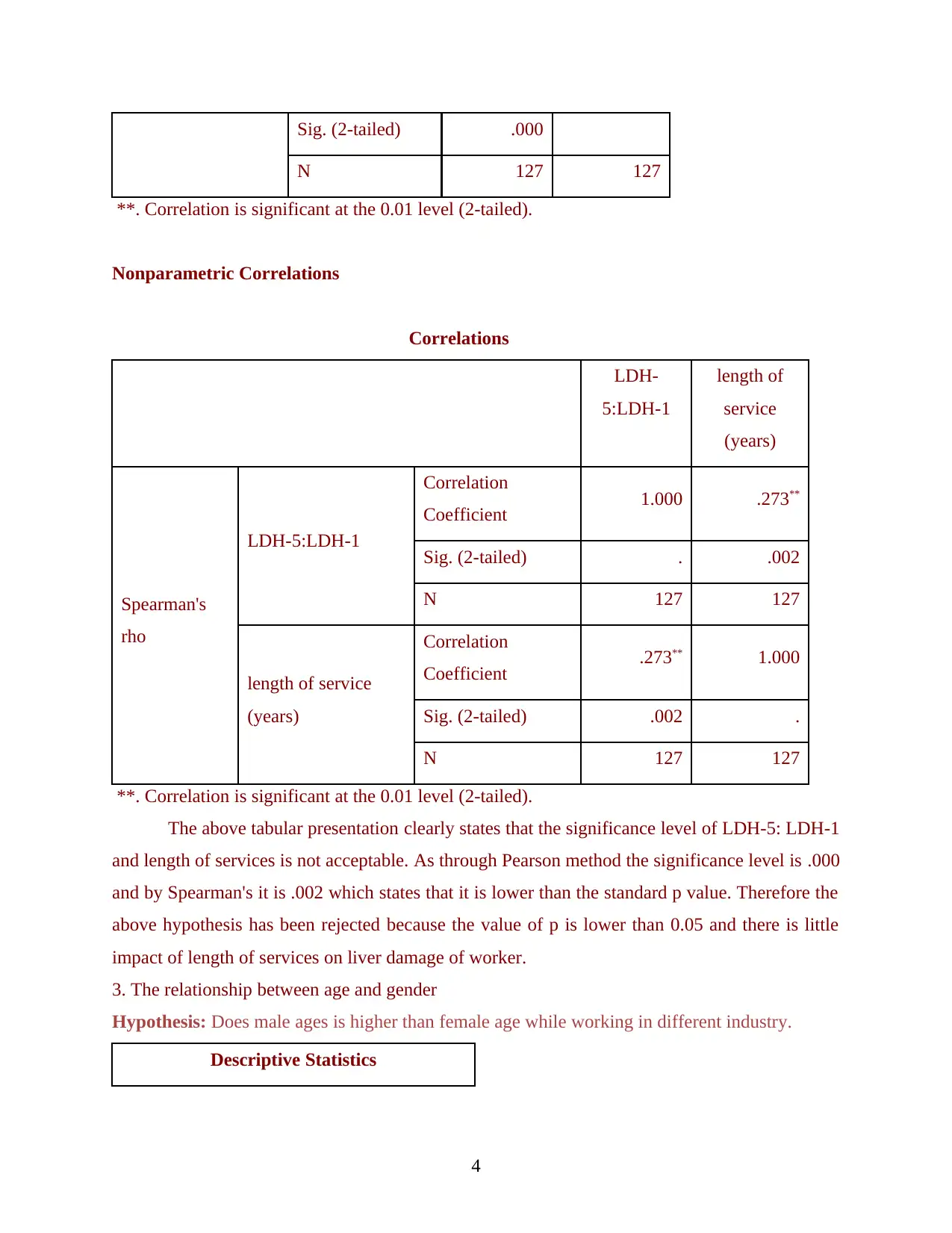
Sig. (2-tailed) .000
N 127 127
**. Correlation is significant at the 0.01 level (2-tailed).
Nonparametric Correlations
Correlations
LDH-
5:LDH-1
length of
service
(years)
Spearman's
rho
LDH-5:LDH-1
Correlation
Coefficient 1.000 .273**
Sig. (2-tailed) . .002
N 127 127
length of service
(years)
Correlation
Coefficient .273** 1.000
Sig. (2-tailed) .002 .
N 127 127
**. Correlation is significant at the 0.01 level (2-tailed).
The above tabular presentation clearly states that the significance level of LDH-5: LDH-1
and length of services is not acceptable. As through Pearson method the significance level is .000
and by Spearman's it is .002 which states that it is lower than the standard p value. Therefore the
above hypothesis has been rejected because the value of p is lower than 0.05 and there is little
impact of length of services on liver damage of worker.
3. The relationship between age and gender
Hypothesis: Does male ages is higher than female age while working in different industry.
Descriptive Statistics
4
N 127 127
**. Correlation is significant at the 0.01 level (2-tailed).
Nonparametric Correlations
Correlations
LDH-
5:LDH-1
length of
service
(years)
Spearman's
rho
LDH-5:LDH-1
Correlation
Coefficient 1.000 .273**
Sig. (2-tailed) . .002
N 127 127
length of service
(years)
Correlation
Coefficient .273** 1.000
Sig. (2-tailed) .002 .
N 127 127
**. Correlation is significant at the 0.01 level (2-tailed).
The above tabular presentation clearly states that the significance level of LDH-5: LDH-1
and length of services is not acceptable. As through Pearson method the significance level is .000
and by Spearman's it is .002 which states that it is lower than the standard p value. Therefore the
above hypothesis has been rejected because the value of p is lower than 0.05 and there is little
impact of length of services on liver damage of worker.
3. The relationship between age and gender
Hypothesis: Does male ages is higher than female age while working in different industry.
Descriptive Statistics
4
⊘ This is a preview!⊘
Do you want full access?
Subscribe today to unlock all pages.

Trusted by 1+ million students worldwide

Mean Std.
Deviation
N
age
(years) 39.12 11.367 127
gender 1.41 .494 127
Correlations
age
(years)
gender
age
(years)
Pearson
Correlation 1 .056
Sig. (2-tailed) .529
N 127 127
gender
Pearson
Correlation .056 1
Sig. (2-tailed) .529
N 127 127
Nonparametric Correlations
Correlations
age
(years)
gender
Spearman's
rho
age
(years)
Correlation
Coefficient 1.000 .051
Sig. (2-tailed) . .566
N 127 127
5
Deviation
N
age
(years) 39.12 11.367 127
gender 1.41 .494 127
Correlations
age
(years)
gender
age
(years)
Pearson
Correlation 1 .056
Sig. (2-tailed) .529
N 127 127
gender
Pearson
Correlation .056 1
Sig. (2-tailed) .529
N 127 127
Nonparametric Correlations
Correlations
age
(years)
gender
Spearman's
rho
age
(years)
Correlation
Coefficient 1.000 .051
Sig. (2-tailed) . .566
N 127 127
5
Paraphrase This Document
Need a fresh take? Get an instant paraphrase of this document with our AI Paraphraser
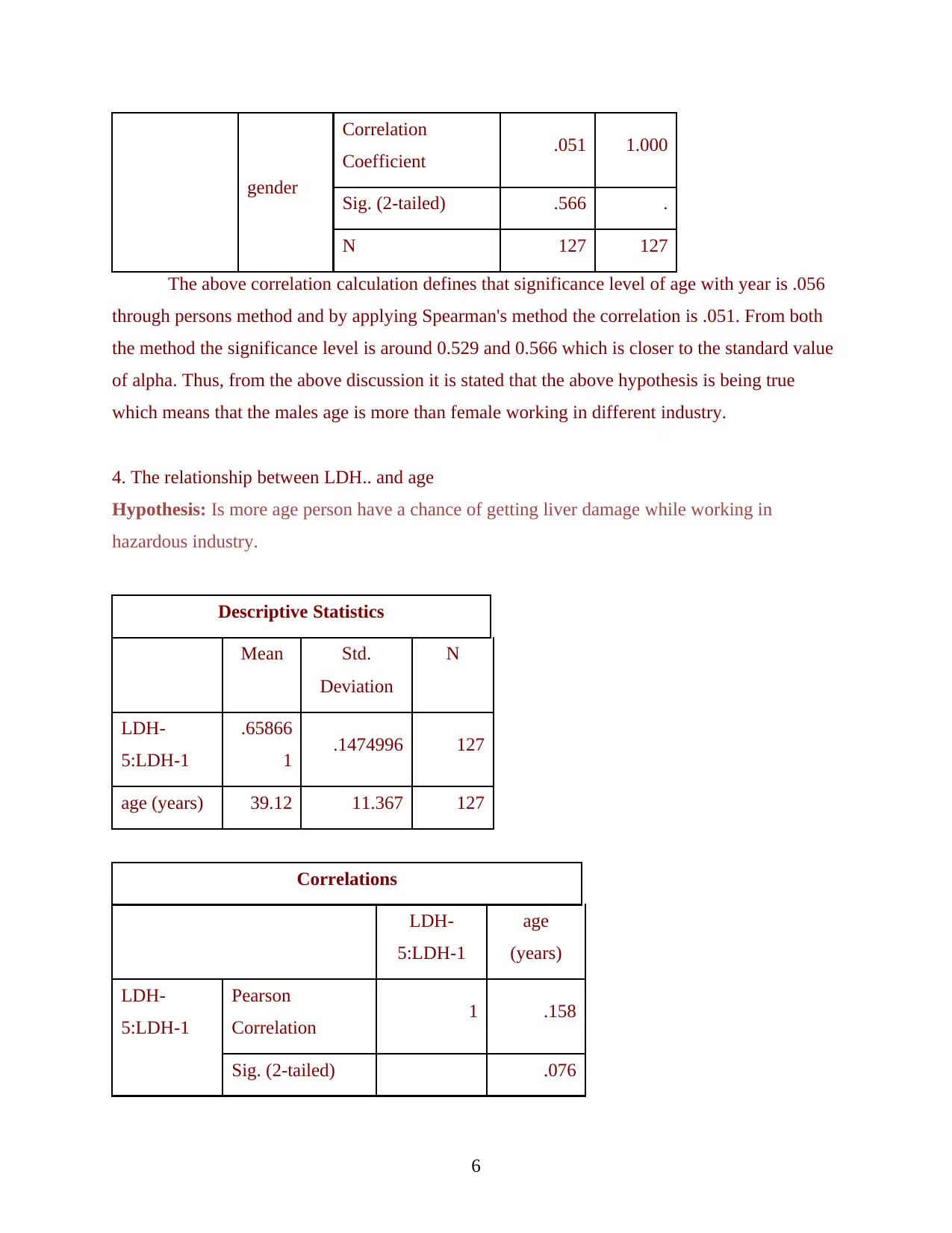
gender
Correlation
Coefficient .051 1.000
Sig. (2-tailed) .566 .
N 127 127
The above correlation calculation defines that significance level of age with year is .056
through persons method and by applying Spearman's method the correlation is .051. From both
the method the significance level is around 0.529 and 0.566 which is closer to the standard value
of alpha. Thus, from the above discussion it is stated that the above hypothesis is being true
which means that the males age is more than female working in different industry.
4. The relationship between LDH.. and age
Hypothesis: Is more age person have a chance of getting liver damage while working in
hazardous industry.
Descriptive Statistics
Mean Std.
Deviation
N
LDH-
5:LDH-1
.65866
1 .1474996 127
age (years) 39.12 11.367 127
Correlations
LDH-
5:LDH-1
age
(years)
LDH-
5:LDH-1
Pearson
Correlation 1 .158
Sig. (2-tailed) .076
6
Correlation
Coefficient .051 1.000
Sig. (2-tailed) .566 .
N 127 127
The above correlation calculation defines that significance level of age with year is .056
through persons method and by applying Spearman's method the correlation is .051. From both
the method the significance level is around 0.529 and 0.566 which is closer to the standard value
of alpha. Thus, from the above discussion it is stated that the above hypothesis is being true
which means that the males age is more than female working in different industry.
4. The relationship between LDH.. and age
Hypothesis: Is more age person have a chance of getting liver damage while working in
hazardous industry.
Descriptive Statistics
Mean Std.
Deviation
N
LDH-
5:LDH-1
.65866
1 .1474996 127
age (years) 39.12 11.367 127
Correlations
LDH-
5:LDH-1
age
(years)
LDH-
5:LDH-1
Pearson
Correlation 1 .158
Sig. (2-tailed) .076
6
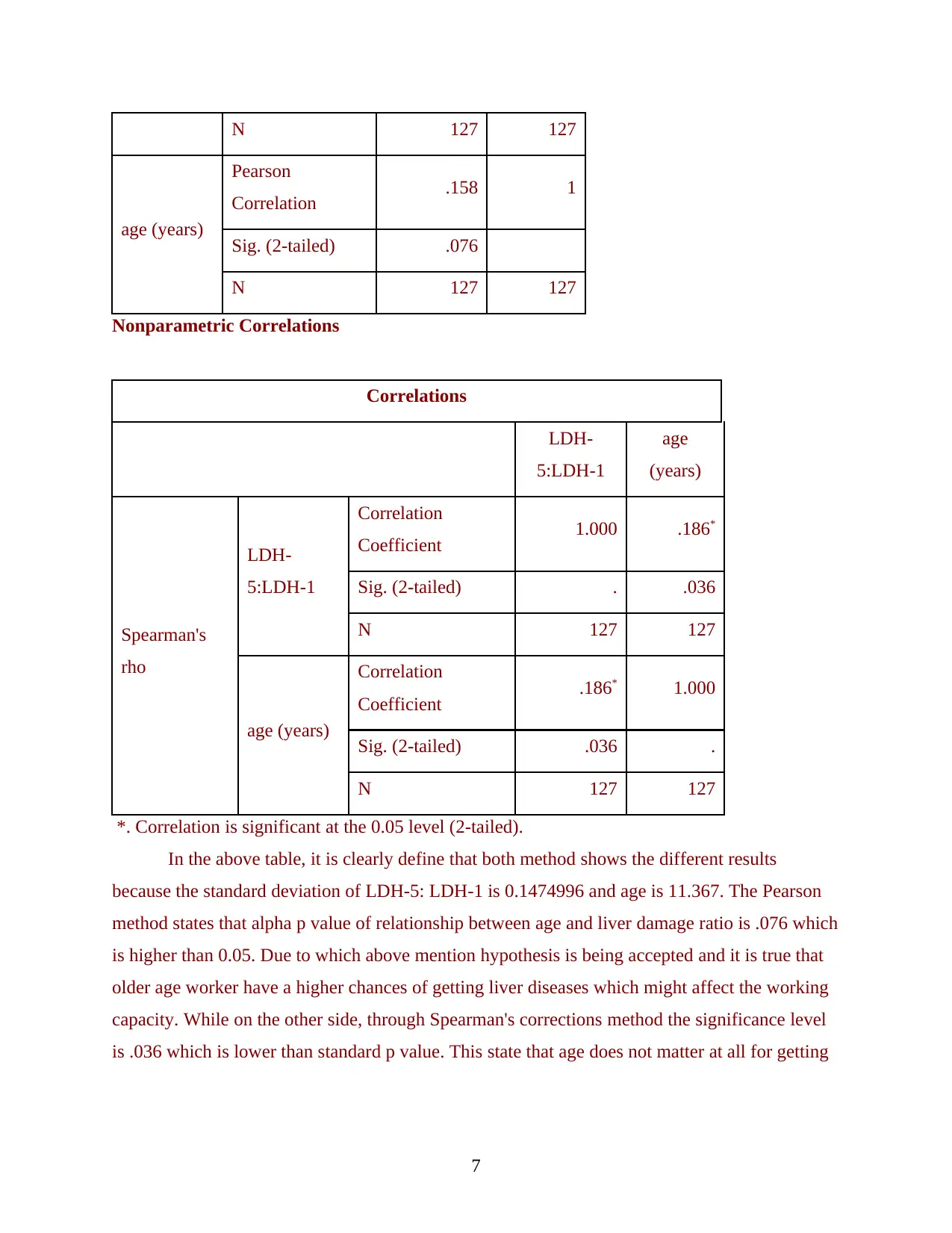
N 127 127
age (years)
Pearson
Correlation .158 1
Sig. (2-tailed) .076
N 127 127
Nonparametric Correlations
Correlations
LDH-
5:LDH-1
age
(years)
Spearman's
rho
LDH-
5:LDH-1
Correlation
Coefficient 1.000 .186*
Sig. (2-tailed) . .036
N 127 127
age (years)
Correlation
Coefficient .186* 1.000
Sig. (2-tailed) .036 .
N 127 127
*. Correlation is significant at the 0.05 level (2-tailed).
In the above table, it is clearly define that both method shows the different results
because the standard deviation of LDH-5: LDH-1 is 0.1474996 and age is 11.367. The Pearson
method states that alpha p value of relationship between age and liver damage ratio is .076 which
is higher than 0.05. Due to which above mention hypothesis is being accepted and it is true that
older age worker have a higher chances of getting liver diseases which might affect the working
capacity. While on the other side, through Spearman's corrections method the significance level
is .036 which is lower than standard p value. This state that age does not matter at all for getting
7
age (years)
Pearson
Correlation .158 1
Sig. (2-tailed) .076
N 127 127
Nonparametric Correlations
Correlations
LDH-
5:LDH-1
age
(years)
Spearman's
rho
LDH-
5:LDH-1
Correlation
Coefficient 1.000 .186*
Sig. (2-tailed) . .036
N 127 127
age (years)
Correlation
Coefficient .186* 1.000
Sig. (2-tailed) .036 .
N 127 127
*. Correlation is significant at the 0.05 level (2-tailed).
In the above table, it is clearly define that both method shows the different results
because the standard deviation of LDH-5: LDH-1 is 0.1474996 and age is 11.367. The Pearson
method states that alpha p value of relationship between age and liver damage ratio is .076 which
is higher than 0.05. Due to which above mention hypothesis is being accepted and it is true that
older age worker have a higher chances of getting liver diseases which might affect the working
capacity. While on the other side, through Spearman's corrections method the significance level
is .036 which is lower than standard p value. This state that age does not matter at all for getting
7
⊘ This is a preview!⊘
Do you want full access?
Subscribe today to unlock all pages.

Trusted by 1+ million students worldwide
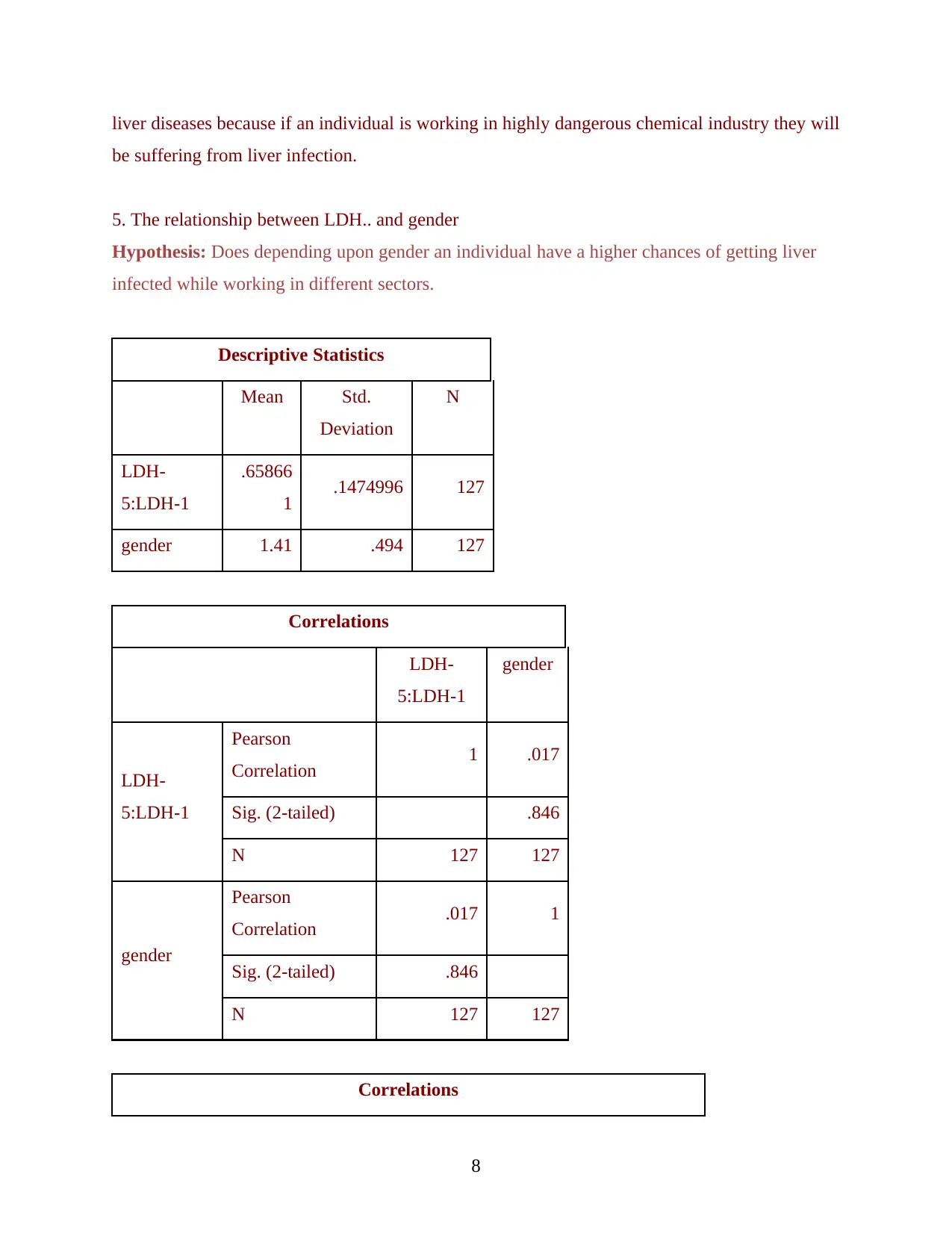
liver diseases because if an individual is working in highly dangerous chemical industry they will
be suffering from liver infection.
5. The relationship between LDH.. and gender
Hypothesis: Does depending upon gender an individual have a higher chances of getting liver
infected while working in different sectors.
Descriptive Statistics
Mean Std.
Deviation
N
LDH-
5:LDH-1
.65866
1 .1474996 127
gender 1.41 .494 127
Correlations
LDH-
5:LDH-1
gender
LDH-
5:LDH-1
Pearson
Correlation 1 .017
Sig. (2-tailed) .846
N 127 127
gender
Pearson
Correlation .017 1
Sig. (2-tailed) .846
N 127 127
Correlations
8
be suffering from liver infection.
5. The relationship between LDH.. and gender
Hypothesis: Does depending upon gender an individual have a higher chances of getting liver
infected while working in different sectors.
Descriptive Statistics
Mean Std.
Deviation
N
LDH-
5:LDH-1
.65866
1 .1474996 127
gender 1.41 .494 127
Correlations
LDH-
5:LDH-1
gender
LDH-
5:LDH-1
Pearson
Correlation 1 .017
Sig. (2-tailed) .846
N 127 127
gender
Pearson
Correlation .017 1
Sig. (2-tailed) .846
N 127 127
Correlations
8
Paraphrase This Document
Need a fresh take? Get an instant paraphrase of this document with our AI Paraphraser
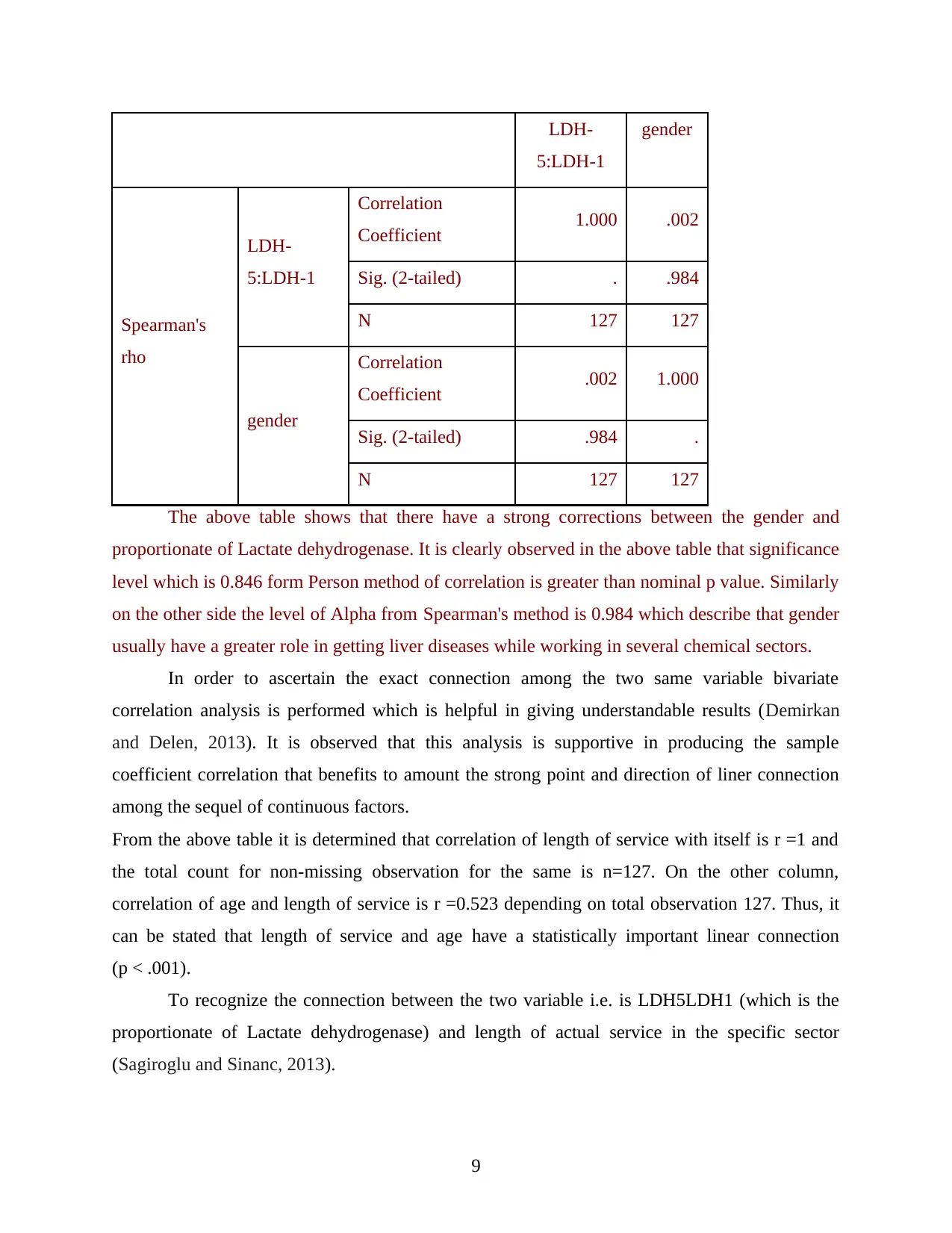
LDH-
5:LDH-1
gender
Spearman's
rho
LDH-
5:LDH-1
Correlation
Coefficient 1.000 .002
Sig. (2-tailed) . .984
N 127 127
gender
Correlation
Coefficient .002 1.000
Sig. (2-tailed) .984 .
N 127 127
The above table shows that there have a strong corrections between the gender and
proportionate of Lactate dehydrogenase. It is clearly observed in the above table that significance
level which is 0.846 form Person method of correlation is greater than nominal p value. Similarly
on the other side the level of Alpha from Spearman's method is 0.984 which describe that gender
usually have a greater role in getting liver diseases while working in several chemical sectors.
In order to ascertain the exact connection among the two same variable bivariate
correlation analysis is performed which is helpful in giving understandable results (Demirkan
and Delen, 2013). It is observed that this analysis is supportive in producing the sample
coefficient correlation that benefits to amount the strong point and direction of liner connection
among the sequel of continuous factors.
From the above table it is determined that correlation of length of service with itself is r =1 and
the total count for non-missing observation for the same is n=127. On the other column,
correlation of age and length of service is r =0.523 depending on total observation 127. Thus, it
can be stated that length of service and age have a statistically important linear connection
(p < .001).
To recognize the connection between the two variable i.e. is LDH5LDH1 (which is the
proportionate of Lactate dehydrogenase) and length of actual service in the specific sector
(Sagiroglu and Sinanc, 2013).
9
5:LDH-1
gender
Spearman's
rho
LDH-
5:LDH-1
Correlation
Coefficient 1.000 .002
Sig. (2-tailed) . .984
N 127 127
gender
Correlation
Coefficient .002 1.000
Sig. (2-tailed) .984 .
N 127 127
The above table shows that there have a strong corrections between the gender and
proportionate of Lactate dehydrogenase. It is clearly observed in the above table that significance
level which is 0.846 form Person method of correlation is greater than nominal p value. Similarly
on the other side the level of Alpha from Spearman's method is 0.984 which describe that gender
usually have a greater role in getting liver diseases while working in several chemical sectors.
In order to ascertain the exact connection among the two same variable bivariate
correlation analysis is performed which is helpful in giving understandable results (Demirkan
and Delen, 2013). It is observed that this analysis is supportive in producing the sample
coefficient correlation that benefits to amount the strong point and direction of liner connection
among the sequel of continuous factors.
From the above table it is determined that correlation of length of service with itself is r =1 and
the total count for non-missing observation for the same is n=127. On the other column,
correlation of age and length of service is r =0.523 depending on total observation 127. Thus, it
can be stated that length of service and age have a statistically important linear connection
(p < .001).
To recognize the connection between the two variable i.e. is LDH5LDH1 (which is the
proportionate of Lactate dehydrogenase) and length of actual service in the specific sector
(Sagiroglu and Sinanc, 2013).
9
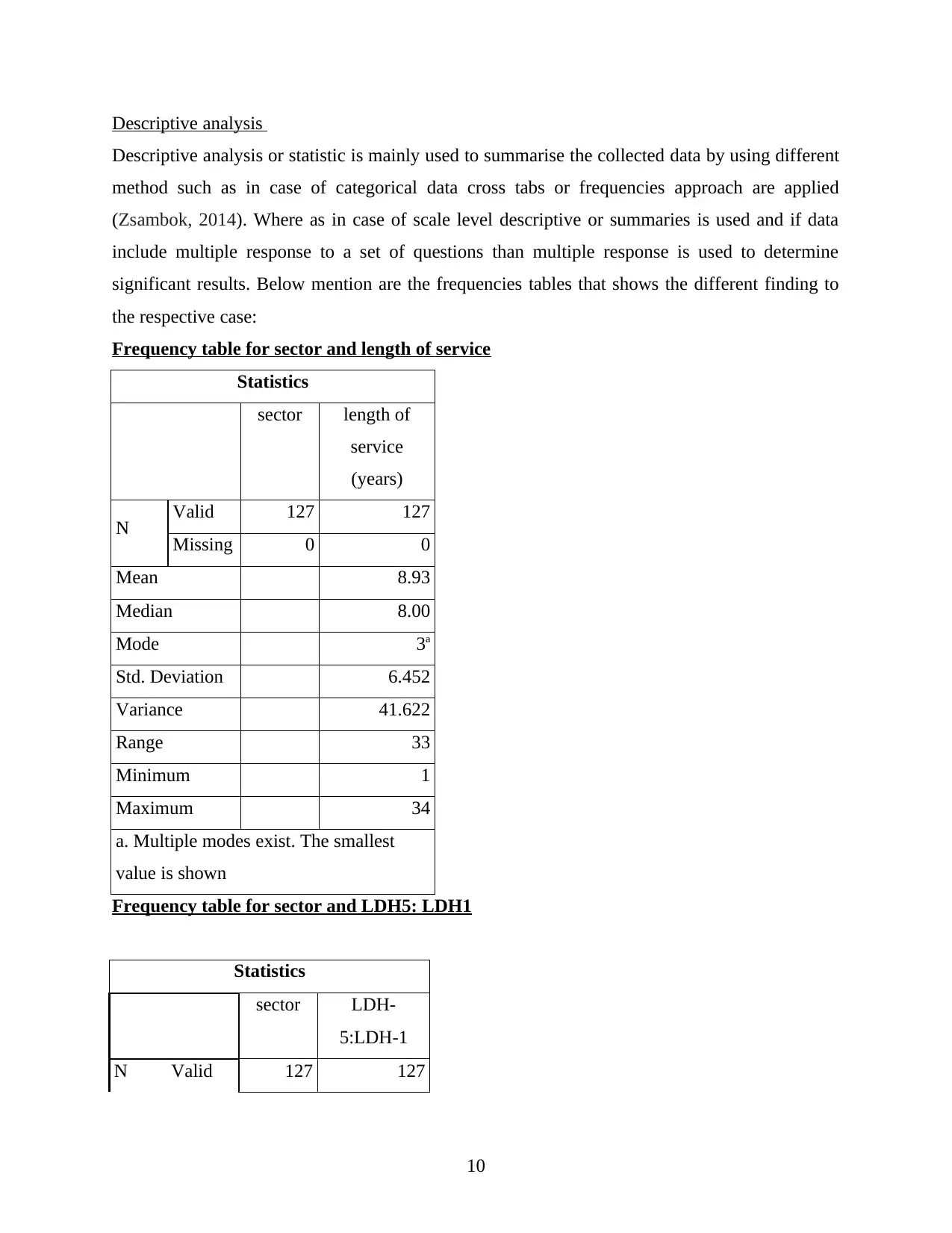
Descriptive analysis
Descriptive analysis or statistic is mainly used to summarise the collected data by using different
method such as in case of categorical data cross tabs or frequencies approach are applied
(Zsambok, 2014). Where as in case of scale level descriptive or summaries is used and if data
include multiple response to a set of questions than multiple response is used to determine
significant results. Below mention are the frequencies tables that shows the different finding to
the respective case:
Frequency table for sector and length of service
Statistics
sector length of
service
(years)
N Valid 127 127
Missing 0 0
Mean 8.93
Median 8.00
Mode 3a
Std. Deviation 6.452
Variance 41.622
Range 33
Minimum 1
Maximum 34
a. Multiple modes exist. The smallest
value is shown
Frequency table for sector and LDH5: LDH1
Statistics
sector LDH-
5:LDH-1
N Valid 127 127
10
Descriptive analysis or statistic is mainly used to summarise the collected data by using different
method such as in case of categorical data cross tabs or frequencies approach are applied
(Zsambok, 2014). Where as in case of scale level descriptive or summaries is used and if data
include multiple response to a set of questions than multiple response is used to determine
significant results. Below mention are the frequencies tables that shows the different finding to
the respective case:
Frequency table for sector and length of service
Statistics
sector length of
service
(years)
N Valid 127 127
Missing 0 0
Mean 8.93
Median 8.00
Mode 3a
Std. Deviation 6.452
Variance 41.622
Range 33
Minimum 1
Maximum 34
a. Multiple modes exist. The smallest
value is shown
Frequency table for sector and LDH5: LDH1
Statistics
sector LDH-
5:LDH-1
N Valid 127 127
10
⊘ This is a preview!⊘
Do you want full access?
Subscribe today to unlock all pages.

Trusted by 1+ million students worldwide
1 out of 25
Your All-in-One AI-Powered Toolkit for Academic Success.
+13062052269
info@desklib.com
Available 24*7 on WhatsApp / Email
![[object Object]](/_next/static/media/star-bottom.7253800d.svg)
Unlock your academic potential
Copyright © 2020–2025 A2Z Services. All Rights Reserved. Developed and managed by ZUCOL.